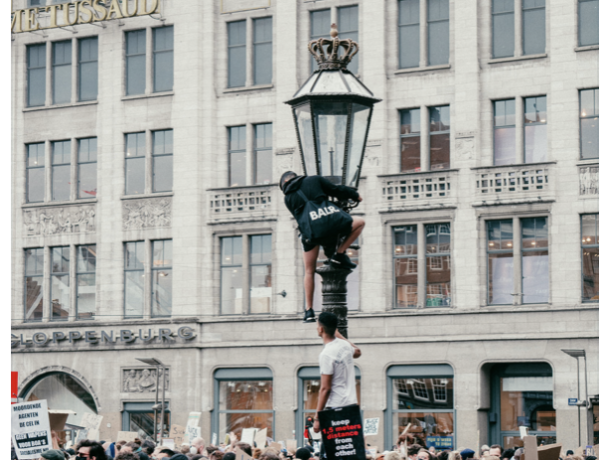There is a term used in today’s society termed as “toxic masculinity”. Although I understand that this term is not intended to imply that masculinity is toxic, that is exactly what it means. Toxic is the adjective used to describe the noun masculinity describing masculinity as toxic. Neither masculinity nor femininity is inherently toxic, but people’s perception of both realities can become toxic. In this article I focus on the way in which an unhealthy perception of masculinity enters gang culture. I hope that by writing this article effective change begins to take root in our communities, developing a healthy understanding of what masculinity is and engendering a deeper appreciation for its feminine counterpart.
Masculine, and thus masculinity is defined by the Cambridge dictionary of American English as: “Having qualities traditionally considered to be suitable for a man”. This definition implies that that which is considered “masculine” varies from community to community and is defined by the shared experiences (traditions) of the members of that specific community.
It is essential that I explain what I mean by “lower class communities”. When I refer to lower class communities, I am referring to those communities of poverty that have been infected with the “culture of criminality”. Criminality is the habitual inclination towards crime, motivated by an inherent disfunction in the institutions tasked with organizing the wealth potential of particular communities. When I use the phrase “communities of poverty” I am not referring to the traditional definition of poverty. When we attempt to define poverty, we are habituated to concentrate on the income status of the individual. Though I agree with income status being used as a defining factor, I do not see it in it of itself as THE defining factor in determining poverty. Gangs are small communities of people formulated in predominately lower-class communities.
Most people whose income level is at or below the poverty line have been regulated to an environment (community) which has been intentionally structured in a way that sustains that measure of income over long periods of time (generations). Living under these conditions for long periods of time produces habituated thought processes and physical inclinations to external stimuli job loss, police aggression, broken education system etc…). These habituated thought processes and physical inclinations create a culture (way of doing things i.e. tradition) of poverty. Thus, to understand how masculinity becomes toxic and manifested in gang culture we must first do three things. One (1), understand what qualities are considered masculine within gang culture, two (2), ask why these qualities are considered masculine and three (3), understand how those qualities became toxic.
In order for us to gain a comprehensive understanding on how such a misperception of masculinity entered gang culture, we must examine the social relations between people in communities that are infected with the disease of gang culture, as traditions of what is masculine is formed by the experiences of people within that specific community. When we examine lower class communities, we notice that dysfunction is prevalent both within and outside the household. Children brought up in these communities are commonly raised in single parent homes with multiple siblings. Because most of the parents within these households were themselves raised in dysfunctional homes, they tend to pass on this dysfunction to their children by neglecting their duties as parents.
Because of this, the child turns to the streets (their community) for a sense of belonging and recognition, indirectly receiving guidance on how to react to certain external stimuli that the child finds himself facing within the community. Within lower class communities it is common for the child to first experience trauma within its household. Because the household is dysfunctional the child never receives the appropriate attention required to teach the child how to develop coping skills for those traumatic experiences and thus, never learns how to cope with the psychological and emotional scars left by such experiences. The child is then sent to the community lost and wounded, seeking an identity that his mother or father was unable to, or unwilling to give him.
The child’s first encounter with his community is normally through school. Most lower-class communities on the west coast are located within the inner cities. These cities have a long practice of intentionally “stratifying” communities dividing affluent communities from non-affluent communities.
Poverty has been directly connected to trauma and because most black people in the inner cities are poor, most black communities suffer from deeply rooted trauma. The cost of living in white neighborhoods prevents black people who are economically poor from gaining residence in predominantly white neighborhoods.
The government has a practice of building schools within specific “zones” within cities. Zones are specific neighborhoods within different communities. On the outskirts of the zone there are division lines. If you live within the division then you go to that specific school. Essentially this means that school attendance is predicated on the neighborhood in which you live. This prevents poor black kids from going to school in white neighborhoods and rich white kids from going to school in poor black neighborhoods.This perpetuates the continued political and economic disparity between white and black peoples, but most importantly it prevents black students from receiving the finer educational benefits that white students receive by nature of the development of their residential neighborhoods.
One of the problems with the public school system in America is that it relegates poor children who have experienced “trauma” into a concentrated environment which is not conducive to the acquisition of the intellectual and economic benefits of education. The system also enables emotionally and psychologically disenfranchised children to pass on this disenfranchisement to other children via the school system. Lower class communities are most affected by criminal gang activity and because schools within lower class communities are built in specific zones they reside in specific gang neighborhoods. Poor children then gain both direct access to gang culture by nature of “direct proximity”, and indirect access by nature of being influenced through the association with kids infected with gang ideology on school campuses. Indirect access enables the school campus to become a micro-community of the specific gang neighborhood in which that school resides.
One of the main attributes of gang culture is its “need” to project aggression. The kids on school campuses who identify with a specific gang are bonded by a shared ideological perspective of life (gang perspective), and thus that which is other than it is considered less than it and must be dominated. This is the internal phenomena that the child first experiences in their interaction with a specific gang.
Aggression is the predominant manifestation of gang culture because violence or aggression is such an integral part of life within lower class communities. Most gang members have experienced some level of violence whether that be within their household (discipline by parents, domestic violence etc..) or outside of the household (shootings, police brutality, fights etc..). Through those experiences violence becomes normalized, and he eventually starts to see violence as a useful tool to assist in the navigation of the violent atmosphere prevalent within lower class communities. But aggression and violence are not the only manifestation of trauma that is embraced in gang culture.
We notice that most males in gang culture have experienced some form of molestation or unhealthy sexual relations at a young age. Because the family unit does not provide the male with a means to effectively address the impact of such an experience, the male starts to minimize his experience of molestation by defining it as “other” than what it is and begins to see it as a demonstration of affection.
Males who suffer through experiences such as these bond with other males who share similar experiences. They become loyal to an ideology (gang perspective) rooted in shared experiences of trauma that most of lower-class society holds in high esteem. This unification in ideology enables these individuals to find value in their identification as gang members, creating a sense of legitimacy in the actions that they exhibit. Because the gang member is seen as thee “defining male” within lower class communities, the actions of gang members are implicitly accepted by members of that community as defining what it means to be male.
Because in gang culture “violence” and “aggression” are used as a defining force
for who is the dominated and who is the dominant, the most violent is considered “strong” and the less violent is considered “weak”. By nature of this reality women are prone to be dominated because they are looked upon as weak. This dominance of women commonly takes the form of sexual objectification. “Bullying” being a common phenomenon in gang culture, the dynamics between the gang member that was bullied, gang culture and women are more complex…( speaking from personal experience).
The bullied are those individuals who exist as a specific type of person whose fundamental qualities are considered “other than” or weak by gang members. For the individual who is bullied growing up in a community where who you fundamentally are is undesirable by the dominant group commonly invites physical violence and has a tendency to make the individual that is being bullied “feel” uncomfortable with who he is. There are many symptoms to this feeling i.e. depression which commonly leads to suicidal or other harmful thoughts but the most common symptom is the complete suppression of the “weak” (feminine) personality traits and the creation of a new, more “strong” (masculine) personality. This reality manifest out of a need for survival within an overly aggressive, false-masculine community. He learns to hate his “self’ or “weak” personality and thus subjugates this personality with his new acquired “strong” personality. He projects this feeling of anti-self (feminine) upon society and thus tends to subjugate the feminine (woman), not out of sexual objectification but out of a hatred for self (as reflected in the feminine).
The emotional and psychological disenfranchisement of each individual gang member is the foundation of what creates gang ideology and thus, the misperception of masculinity in gang culture are the effects of unresolved trauma of the individual gang members. In fact, the traditions defining masculinity in gang culture are the coping mechanisms of children within poor communities to the deplorable conditions of those communities.
I hope that this information would aid in first understanding the root of the problem of how the misperception of masculinity is developed in lower class communities becoming rooted in gang culture, and second would be used to develop comprehensive policies that would address the dynamics of society in ways in which would rid communities of the social ills that engender this false perception of masculinity.






No Comments